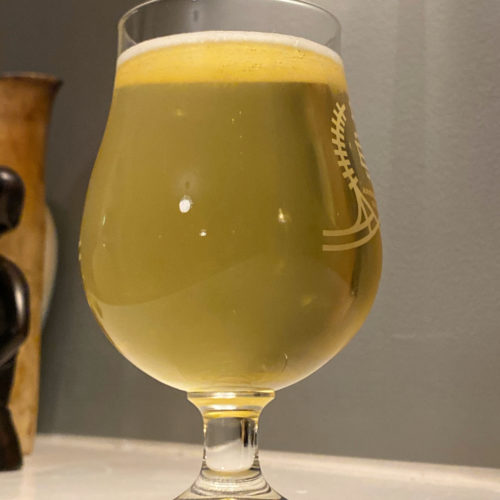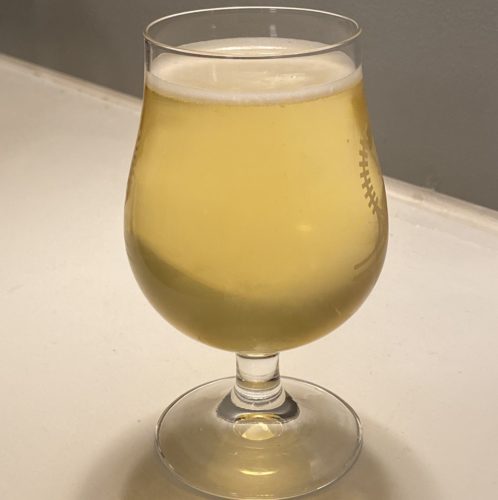Homebrew #93: 2019 Seattle Cider
¶ by Rob FrieselThis one doesn’t get a name. Kinda/sorta/more-or-less like last year. I could name it, but it would be a dumb name. Instead, it’s just the 2019 Seattle Cider — 100% Jonagold juice fermented with Danstar Nottingham. See?

There isn’t that much to say about this one. A brief description of the raw materials I picked up, and a brief lament about what I didn’t do.
First: I got an email from one of the local homebrew supply stores that they were having someone come in with a bulk quantity of apple cider-making juice for pick-up. Having gotten at-least satisfactory results last year, I figured that I would go for it. At a minimum, it would be a low-effort beverage to have on draught for the winter. And given last year’s blend, I thought it would be fun to do a single-varietal cider for a change.
The provider promised juice pressed from 100% Jonagold apples. The email read like so:
Developed through the blending of the Golden Delicious apple and Jonathan apple, Jonagolds are popular because of their sweet tanginess and tart flesh. With a yellow top and a red bottom, this apple is a refreshing snack and perfect for using to create hard cider. The flesh is aromatic with honey-like flavor notes and tangy-sweet thanks to moderate acidity.
And while I’ve never heard of Jonathan apples before, Golden Delicious are one of my all-time-favorite snacking apples. Sign me up!
Second: the lament has to do with the decision I didn’t manage to make ahead of time. Given how low-effort cider generally is, I thought that it might be fun to do the first 5 gallon share “straight” and then experiment with the second 5 gallon share. Hot off the heels of this fascinating story about Vermont’s Krista Scruggs, I wanted to try my hand at a cider-wine hybrid. But I had trouble 1 ascertaining whether I could get some decent grape must concentrate or whatever… And then I couldn’t decide on fruit purees to make a fruited cider… AND THEN I chickened out on making a cyser because of just how expensive good honey can be and… Well, you can insert the grimacing face emoji here.
Nevertheless — I got my 5 gallon share for the “straight” cider ordered, and in late November, we were off to the races.
“Brew Day”
The quotes are because… we’re just picking up juice.

I drove down to South Seattle. I picked up my 5 gallon share of juice. (OK and a couple of other things.) I drove home.
The juice’s O.G. was 1.050, if you’re keeping score.
I brought the juice home, and added 2 tsp. of pectic enzyme, and 2 oz. of yeast nutrient, and 5 crushed Campden tablets.
I waited 24 hours and hit it with one sachet of Danstar Nottingham English ale yeast.
Why Nottingham? Because I had some on hand that I needed to use up, and I’d heard from some people that it does a decent job with cider. So that’s what it’s gonna get.
Fermentation
I mostly left it alone after yeast was pitched.

I mean… what else is there to do except count airlock bubbles and check temperatures and take the occasional gravity reading?
And/but/so on that note… Nottingham took its sweet-ass time to get started, and then took its sweet-ass time to finish. Nutrient deficiency? Lack of Oâ‚‚ early on? Poor initial yeast health? Who knows?
In any case, by the time we get to mid-December, gravity appears to have finished dropping, and there’s no more activity in the airlock. The cider is sitting at 1.000 and a pH of 3.56. There’s a little sulfur on the nose, but it blows off — nothing offensive. Time to get it packaged…
…which takes another week or two to get all my ducks in a row. Nevertheless, just under 5 gallons of cider goes from the carboy into a keg. And I have at it with my first ever crank-and-shake carbonation. 2
So how did this cider turn out?
Overall Impressions
A moderately tart but refreshing cider.

AROMA. Low sulfur note leads but blows off fairly quickly. Moderate apple notes: red skins, ripe flesh — distinctive but not strong. Low tart notes. No significant alcohol. Very low esters. No detectable phenolics.
APPEARANCE. Pale yellow color. Quite clear. No significant legs. Many small fast-rising bubbles from the sparkling carbonation. Tall white mousse collapsed into a substantial and persistent cordon.
FLAVOR. Moderate and distinctive apple flavor — tastes like a mix of semi-sweet reds and tart greens. No significant sweetness; dry finish. Acidity reads as moderately and softly tart. Low tannins provide some structure. Perceptible warming alcohol, but low. Medium-high sparkling carbonation. Medium body. Finishes with a distinct fruitiness which fades into a lingering tart character. Some of the blown-off sulfur is detectable retronasally.
OVERALL IMPRESSION. A very good, and competently made example of the style. Retains enough fruit character through an otherwise thorough fermentation, without also over-expressing yeast character. The sulfur notes detract somewhat; consider a more thorough degassing, aging somewhat longer, or else bubbling COâ‚‚ through the cider to push more out of solution. Sweetness, acidity, and tannin seem roughly in balance for style. That said, the cider itself is not particularly memorable … but then again I’m not much of a cider judge.
What would I change for next time? No idea. I would be fun to follow-through on my original plan of doing multiple batches with different adjuncts and/or yeast. But that’s a story for the 2020 batch.
Recipe
The recipe for 2019 Seattle Cider is as follows:
Fermentables
5 gallons unpasteurized Jonagold apple juice
Yeast
Danstar Nottingham (1 sachet)
Brew Day
- Collect 5 gallons of unpasteurized Jonagold apple juice.
- Dose juice with 2 tsp. pectic enzyme, 2 oz. yeast nutrient, and 5 crushed Campden tablets. Let sit 24 hours.
- Pitch 1 sachet Danstar Nottingham yeast.
- Start fermentation in the low-60s ºF.
Beyond Brew Day
- Keep cider fermenting in the low- to mid-60s ºF range until fermentation completes (approx. 2-4 weeks).
- Gently siphon cider off lees into a keg.
- Force carbonate to approx. 2.5 volumes of COâ‚‚.
- Enjoy!
Details
2019 Seattle Cider, a New World Cider by Tilde Gravitywerks
| Original Gravity | 1.050 |
| Final Gravity | 1.000 |
| ABV | 6.6% |
| Attenuation | 100.0% |
| SRM | 1 |
| Links | Flickr |
- In other words: the website didn’t say, and I didn’t bother to call … because I hate calling.[↩]
- In retrospect, crank-and-shake it just a violent way to treat a beverage and really not worth it. All the shaking puts every last bit of haze back into suspension. Oh, and you’re running a lot of risk of putting fermented whatever up into your COâ‚‚ lines and/or regulator and that is NOT what you want.[↩]
Leave a Reply